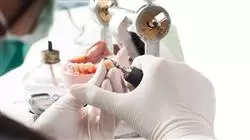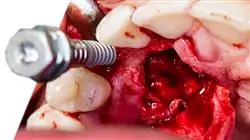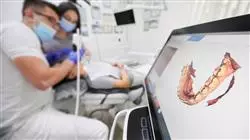University certificate
The world's largest faculty of dentistry”
Description
Bring yourself to date in the modern handling of documentary and bibliographic sources, with a complete tour through advanced bibliographic search, metadata extraction and scientific methodology to be followed"

With the continuing changes in the eating habits of the population, coupled with a preponderance of ultra-processed products, today's dentists face an unparalleled set of challenges. Gingivitis, periodontitis, dental caries and even oral cancer sadly have become frequent which drives to apply a more thorough process and with greater projection by specialists in this area.
Fortunately, new technologies and medical advances have made it possible to improve dental processes considerably, making research in this field more important than ever. The number of tools available to the dentist, as well as the evolution of the scientific landscape in recent decades, requires constant updating by specialists who wish to devote themselves to Medical Research.
For this reason, TECH Global University has created the present academic program, with the support of a group of advanced experts and professionals both in the field of Medicine and in research and data collection. Its advanced knowledge provides all the contents with a necessary practical vision, enriching the theory with simulated cases and real examples that contextualize the most advanced research methodology.
In this way, the dentist will delve into the syllabus in the generation of research projects, from its own genesis to the publication of results, through the leadership of working groups or the management of R computer language for data processing. This is a great opportunity to get up to date in Medical Research with the most rigorous and current scientific content.
The format of this Professional Master’s Degree is 100% online, which means that all the contents are available on the virtual campus. In addition, these contents can be downloaded from any device with an Internet connection, whether it is a computer or smart phone of choice, with total access to them wherever, whenever and however desired. Thus, the dentists will be able to combine the update involved in this program with their daily work or personal responsibilities, without having to give up any of them.
Delve into the types of clinical trials, protocol generation and various ethical aspects to incorporate them immediately into your own work methodology in the field of research"
This Professional Master’s Degree in Medical Research contains the most complete and up-to-date scientific program on the market. The most important features include:
- The development of case studies presented by experts in Health Sciences Research
- The graphic, schematic, and practical contents with which they are created, provide scientific and practical information on the disciplines that are essential for professional practice
- Practical exercises where the self-assessment process can be carried out to improve learning
- Its special emphasis on innovative methodologies
- Theoretical lessons, questions to the expert, debate forums on controversial topics, and individual reflection assignments
- Content that is accessible from any fixed or portable device with an Internet connection
Throughout the program you will delve into the creation, financing and publication of research projects, with topics dedicated to biostatistics, generation of scientific reports and data protection"
The program’s teaching staff includes professionals from the industry who contribute their work experience to this program, as well as renowned specialists from leading societies and prestigious universities.
The multimedia content, developed with the latest educational technology, will provide the professional with situated and contextual learning, i.e., a simulated environment that will provide immersive education programmed to learn in real situations.
This program is designed around Problem-Based Learning, whereby the professional must try to solve the different professional practice situations that arise during the academic year For this purpose, the students will be assisted by an innovative interactive video system created by renowned and experienced experts.
You will be able to download all the contents, including the extensive library of multimedia resources available in this program, being able to review them from the comfort of your Smartphone or Tablet of choice"

You will have full access to the virtual campus 24 hours a day, so you can study the teaching load at your own pace, without the usual pressure of travel to physical locations or classes with fixed schedules"
Syllabus
TECH Global University elaborates all its programs based on the Relearning pedagogical methodology, which allows a maximum use of all the didactic contents offered. The dentists will review the essential concepts and fundamentals of Medical Research in a repetitive and progressive manner throughout the entire syllabus, resulting in a much more natural and learning experience. All topics are reinforced with detailed videos, interactive summaries and complementary readings that expand the knowledge offered in an enjoyable way.

By being able to download all the contents offered on the virtual campus you will be creating a reference guide that will be useful even after you complete your degree"
Module 1. The Scientific Method Applied to Health Research. Bibliographic Positioning of the Research
1.1. Definition of the Question or Problem to be Solved
1.2. Bibliographic Positioning of the Question or Problem to be Solved
1.2.1. Information Search
1.2.1.1. Strategies and Keywords
1.2.2. Pubmed and Other Repositories of Scientific Articles
1.3. Treatment of Bibliographic Sources
1.4. Treatment of Documentary Sources
1.5. Advanced Bibliography Search
1.6. Generation of Reference Bases for Multiple Use
1.7. Bibliography Managers
1.8. Extraction of Metadata in Bibliographic Searches
1.9. Definition of the Scientific Methodology to be Followed
1.9.1. Selection of the Necessary Tools
1.9.2. Design of Positive and Negative Controls in an Investigation
1.10. Translational Projects and Clinical Trials: Similarities and Differences
Module 2. Generation of Working Groups: Collaborative Research
2.1. Definition of Working Groups
2.2. Formation of Multidisciplinary Teams
2.3. Optimal Distribution of Responsibilities
2.4. Leadership
2.5. Control of Activities Achievement
2.6. Hospital Research Teams
2.6.1. Clinical Research
2.6.2. Basic Research
2.6.3. Translational Research
2.7. Creation of Collaborative Networks for Health Research
2.8. New Spaces for Health Research
2.8.1. Thematic Networks
2.9. Networked Biomedical Research Centers
2.10. Biobanks of Samples International Collaborative Research
Module 3. Generation of Research Projects
3.1. General Structure of a Project
3.2. Presentation of Background and Preliminary Data
3.3. Definition of the Hypothesis
3.4. Definition of General and Specific Objectives
3.5. Definition of the Type of Sample, Number and Variables to be Measured
3.6. Establishment of the Scientific Methodology
3.7. Exclusion/Inclusion Criteria in Projects with Human Samples
3.8. Establishment of the Specific Team: Balance and Expertise
3.9. Expectations: An Important Element that we Forget
3.10. Budget Generation: a fine Tuning Between the Needs and the Reality of the Call
3.11. Ethical Aspects
Module 4. The Clinical Trial in Health Research
4.1. Types of Clinical Trials (CT)
4.1.1. Clinical Trials Promoted by the Pharmaceutical Industry
4.1.2. Independent Clinical Trials
4.1.3. Drug Replacement
4.2. Phases of CE
4.3. Main Figures Involved in CE5
4.4. Generation of Protocols
4.4.1. Randomization and Masking
4.4.2. Non-Inferiority Studies
4.5. Ethical Aspects
4.6. Patient Information Sheet
4.7. Informed Consent
4.8. Good Clinical Practice Criteria
4.9. Drug Research Ethics Committee
4.10. Search for Funding for Clinical Trials
4.10.1. Public. Main Spanish, European, Latin American and U.S. Agencies
4.10.2. Private. Main Pharmaceutical Companies
Module 5. Project Financing
5.1. Search for Financing Opportunities
5.2. How to Adjust a Project to the Format of a Call for Proposals?
5.2.1. Keys to Success
5.2.2. Positioning, Preparation and Writing
5.3. Public Calls for Proposals. Main European and American Agencies
5.4. Specific European Calls for Proposals
5.4.1. Horizon 2020 Projects
5.4.2. Human Resources Mobility
5.4.3. Madame Curie Program
5.5. Intercontinental Collaboration Calls, Opportunities for International Interaction
5.6. Calls for Collaboration with the United States
5.7. Strategy for Participation in International Projects
5.7.1. How to Define a Strategy for Participation in International Consortia
5.7.2. Support and Assistance Structures
5.8. International Scientific Lobbying
5.8.1. Access and Networking
5.9. Private Calls for Proposals
5.9.1. Foundations and Funding Organizations for Health Research in Europe and the Americas
5.9.2. Private Funding Calls for Proposals from U.S. Organizations
5.10. Securing the Loyalty of a Funding Source: Keys to Lasting Financial Support
Module 6. Statistics and R in Health Research
6.1. Biostatistics
6.1.1. Introduction to The Scientific Method
6.1.2. Population and Sample. Sampling Measures of Centralization
6.1.3. Discrete Distributions and Continuous Distributions
6.1.4. General Outline of Statistical Inference. Inference about a Normal Population Mean. Inference about a General Population Mean
6.1.5. Introduction to Nonparametric Inference
6.2. Introduction to R
6.2.1. Basic Features of the Program
6.2.2. Main Object Types
6.2.3. Simple Examples of Simulation and Statistical Inference
6.2.4. Graphs
6.2.5. Introduction to R Programming
6.3. Regression Methods with R
6.3.1. Regression Models
6.3.2. Variable Selection
6.3.3. Model Diagnosis
6.3.4. Treatment of Outliers
6.3.5. Regression Analysis
6.4. Multivariate Analysis with R
6.4.1. Description of Multivariate Data
6.4.2. Multivariate Distributions
6.4.3. Dimension Reduction
6.4.4. Unsupervised Classification: Cluster Analysis
6.4.5. Supervised Classification: Discriminant Analysis
6.5. Regression Methods for Research with R
6.5.1. Generalized Linear Models (GLM): Poisson Regression and Negative Binomial Regression
6.5.2. Generalized Linear Models (GLM): Logistic and Binomial Regressions
6.5.3. Poisson and Negative Binomial Regression Inflated by Zeros
6.5.4. Local Fits and Generalized Additive Models (GAMs)
6.5.5. Generalized Mixed Models (GLMM) and Generalized Additive Mixed Models (GAMM)
6.6. Statistics Applied to Biomedical Research with R I
6.6.1. Basic Notions of R. Variables and Objects in R. Data handling. Files Graphs
6.6.2. Descriptive Statistics and Probability Functions
6.6.3. Programming and Functions in R
6.6.4. Contingency Table Analysis
6.6.5. Basic Inference with Continuous Variables
6.7. Statistics Applied to Biomedical Research with R II
6.7.1. Analysis of Variance
6.7.2. Correlation Analysis
6.7.3. Simple Linear Regression
6.7.4. Multiple Linear Regression
6.7.5. Logistic Regression
6.8. Statistics Applied to Biomedical Research with R III
6.8.1. Confounding Variables and Interactions
6.8.2. Construction of a Logistic Regression Model
6.8.3. Survival Analysis
6.8.4. Cox Regression
6.8.5. Predictive Models. ROC Curve Analysis
6.9. Statistical Data Mining Techniques with R I
6.9.1. Introduction. Data Mining. Supervised and Unsupervised Learning. Predictive Models. Classification and Regression
6.9.2. Descriptive Analysis. Data Pre-Processing
6.9.3. Principal Component Analysis (PCA)
6.9.4. Cluster Analysis. Hierarchical Methods. K-Means
6.10. Statistical Data Mining Techniques with R II
6.10.1. Model Assessment Measures. Predictive Ability Measures. ROC Curves
6.10.2. Models Assessment Techniques. Cross-Validation. Bootstrap Samples
6.10.3. Tree-Based Methods (CART)
6.10.4. Support Vector Machines (SVM)
6.10.5. Random Forest (RF) and Neural Networks (NN)
Module 7. Graphical Representations of Data in Health Research and Other Advanced Analysis
7.1. Types of Graphs
7.2. Survival Analysis
7.3. ROC Curves
7.4. Multivariate Analysis (Types of Multiple Regression)
7.5. Binary Regression Models
7.6. Massive Data Analysis
7.7. Dimensionality Reduction Methods
7.8. Comparison of Methods: PCA, PPCA and KPCA
7.9. T-SNE (t-Distributed Stochastic Neighbor Embedding)
7.10. UMAP (Uniform Manifold Approximation and Projection)
Module 8. Dissemination of Results I, Reports, Memos and Scientific Articles
8.1. Generating a Scientific Report or Memory of a Project
8.1.1. Optimal Approach to the Discussion
8.1.2. Presentation of the Limitations
8.2. Generation of a Scientific Article: How to Write a Paper on the Basis of the Data Obtained?
8.2.1. General Structure
8.2.2. Where Does the Paper Go?
8.3. Where to Start?
8.3.1. Adequate Representation of the Results
8.4. Introduction: The Mistake of Starting with this Section
8.5. Discussion: The Cusp Moment
8.6. The Description of Materials and Methods: The Guaranteed Reproducibility
8.7. Choice of the Journal where the Paper is to be submitted
8.7.1. Choice Strategy
8.7.2. Priority List
8.8. Adaptation of the Manuscript to the Different Formats
8.9. The “Cover Letter”: Concise Presentation of the Study to the Editor
8.10. How to Respond to Reviewers’ Doubts? The Rebuttal Letter
Module 9. Dissemination of Results II, Symposiums, Congresses, Dissemination to the Society
9.1. Presentation of Results at Congresses and Symposia
9.1.1. How is a Poster Generated?
9.1.2. Data Representation
9.1.3. Focusing the Message
9.2. Short Communications
9.2.1. Data Representation for Short Communications
9.2.2. Focusing the Message
9.3. The Plenary Lecture: Notes on How to Keep the Attention of the Specialized Audience for More than 20 Minutes
9.4. Dissemination to the General Public
9.4.1. Need Vs. Opportunity
9.4.2. Use of References
9.5. Use of Social Networks for the Dissemination of Results
9.6. How to Adapt Scientific Data to the Popular Language?
9.7. Hints for Summarizing a Scientific Paper in a Few Characters
9.7.1. Instant Dissemination via Twitter
9.8. How to turn a Scientific Paper into a Popularization Material
9.8.1. Podcast
9.8.2. YouTube Videos
9.8.3. Tik Tok
9.8.4. Comic Book
9.9. Popular Literature
9.9.1. Columns
9.9.2. Books
Module 10. Protection and Transfer of Results
10.1. Protection of Results: General Aspects
10.2. Valorization of the Results of a Research Project
10.3. Patents: Pros and Cons
10.4. Other Forms of Protection of Results
10.5. Transfer of Results to Clinical Practice
10.6. Transfer of Results to Industry
10.7. The Technology Transfer Contract
10.8. Trade Secrets
10.9. Generation of Companies Spin-Off from a Research Project
10.10. Search for Investment Opportunities in companies Spin-Off

The numerous self-knowledge exercises and evaluation tests will help you to follow your progress and consolidate all the theoretical contents of this Professional master’s degree"
Professional Master's Degree in Medical Research
TECH's Professional Master's Degree in Medical Research is the perfect online postgraduate program for those interested in dentistry and the research field. With an up-to-date syllabus and the best experts in the field, you'll learn the most innovative medical research techniques applied to dentistry. Study at your own pace and from anywhere in the world, without having to interrupt your professional career. Become an expert in medical research and gain access to a unique world of career opportunities in dentistry. Enroll now in TECH and transform your future!







